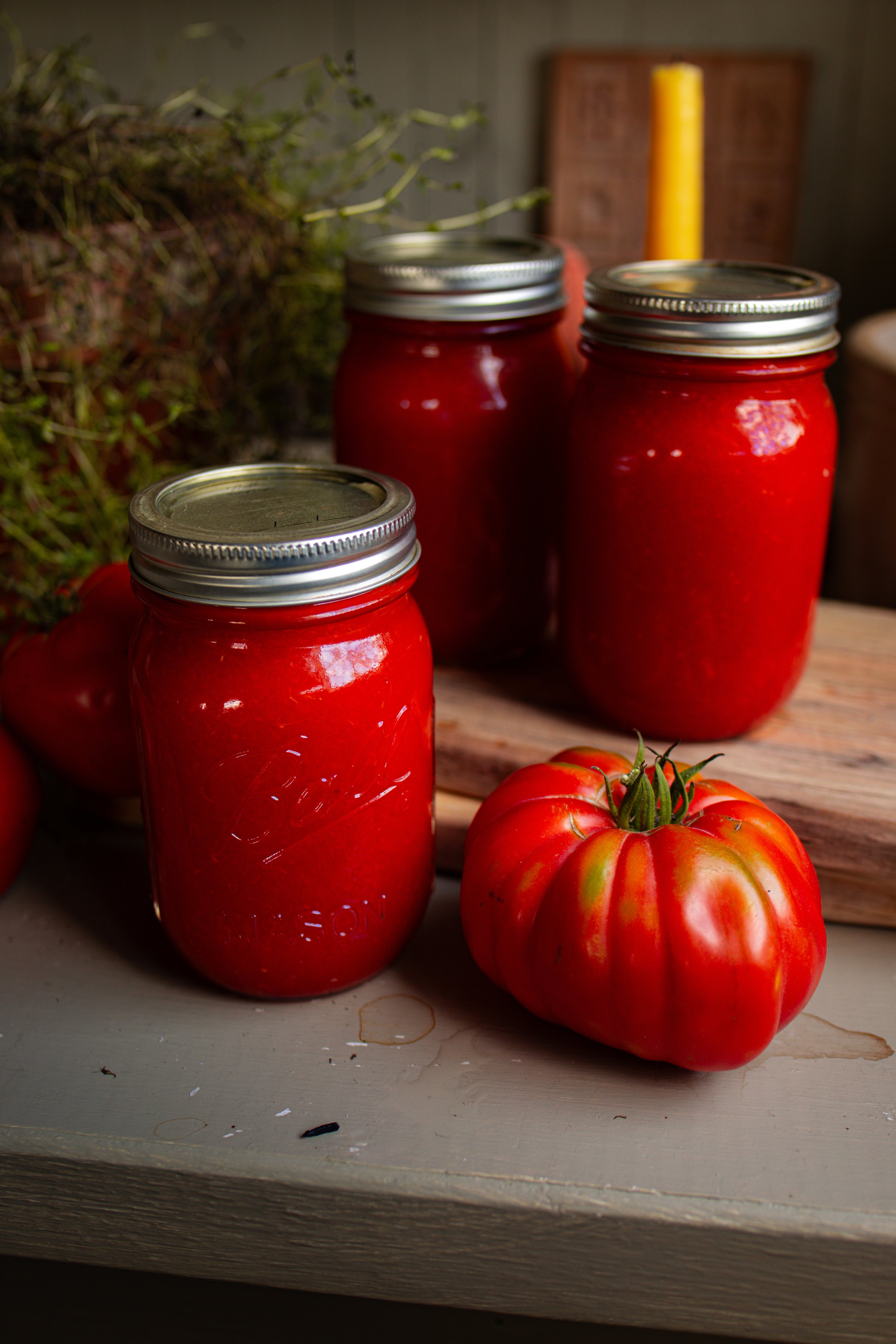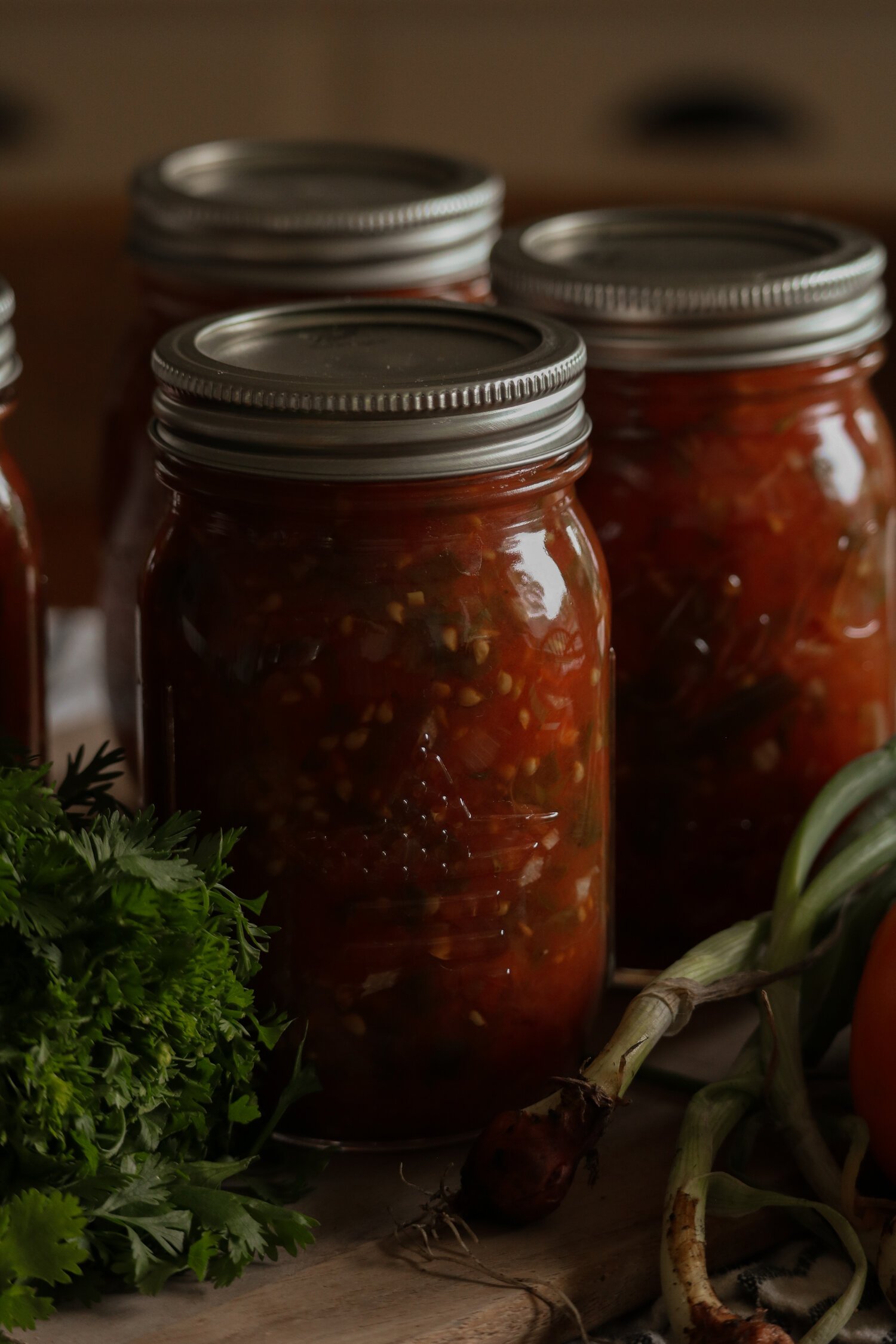Tomato Sauce: Canning Recipe and Guide
This post may contain affiliate links, please see our privacy policy for more information.
Do you grow your own tomatoes? I am so excited to share my homemade tomato sauce recipe and tomato sauce canning guide with you all. Canning tomatoes is my absolute favorite product to preserve. While I love jams, jellies, and pickles, too, tomatoes hold a special place in my heart. Before I learned to can myself at home, canned tomatoes were what I went through the most from the canned goods I would purchase at the store.
Now that I grow and preserve my own tomatoes, I have my own little grocery store supply that I can dip into throughout the winter. Homegrown tomatoes taste so much better than any you could purchase at the grocery store, and they are made with love! I hope that you enjoy this canning guide for tomato sauce.
canning tips:
If you have never canned before, please read this post all about using a hot water bath canner. It is always good to be refreshed on canning safety!
Use New Lids. Canning lids are really only meant to be used once! I have tried all sorts, and while I am a Ball® Ambassador, I have only really had success with the Ball® lids. They seal for 18+ months, keeping your food fresh and shelf stable. As the seals become indented after their first use, it is safest to use new lids each and every time that you can.
Assembly Line Can. When I first started canning 10 seasons ago, I would pull all of my jars out of the canner and onto the countertop. Then, I would fill all of the jars and place them back into the canner. It wasn’t until a year or two later that I learned this was a big no-no! As you want all of your jars and the food to stay hot, the best method is to assembly line can your food. This means to fill up one jar at a time, put on the lid and band, and then place it back into the canner. Then, pull out and fill the next jar.
Use Plastic Utensils. To prevent possibly cracking your jars, use plastic or wooden tools to remove air bubbles and ladle in the jam.
Begin Processing When the Water is Boiling. Do not start counting the processing time of the jars until the water is boiling. Then, do not uncover the pot until the processing time is over!
Check Seals After 12-24 Hours. After the jars have been removed from the canner, leave the rings on for at least 12 hours. Remove the rings and use the fingertip test to see if the lids are sealed. Lift the jar by the lid 1-2 inches from the countertop with your fingertips. If the lid stays attached to the jar, then the jar is sealed! Store the sealed jars in a dark place without the rings on to ensure the seal stays true.
how to can tomatoes:
To properly can tomatoes, you can use a hot water bath canner or a pressure canner. It will depend upon the style of tomatoes that you are wanting to make! As tomatoes are a high-acid food, they can be safely canned in a hot water bath canner with the addition of some lemon juice or citric acid. If you would like to can tomatoes with lemon juice or citric acid, they should be canned in a pressure canner.
Tomatoes that are going to be used for canning should be disease-free and are firm and ripened fully. I recently learned that green tomatoes are more acidic than red tomatoes, so they do not need additional acid in the jar to be canned safely!
For safe tomato canning, 1 tablespoon (15 ml) of lemon juice or 1/4 teaspoon of citric acid should be added to every pint (16 oz) jar. Sugar can also be added to offset the acidic taste of tomatoes, especially for sauce making.
making tomato sauce:
To make this tomato sauce, I actually tried an entirely new-to-me method, and I saved so much time. Oh my goodness.
This is my first year using a food mill, and it has changed my entire canning game. I used to blanch my tomatoes in boiling hot water, transfer them to an ice water bath, and peel the skins off. Then I would remove the core and seeds by hand and cook them into a sauce.
With the food mill, I was able to simply cook down the tomatoes with the skins and seeds in the pot, then once they had boiled down into the sauce I just ran them through the mill. The skins and seeds were discarded in the mill, and I was left with perfect sauce. I highly recommend getting a food mill, if you can!
final thoughts:
I hope that you enjoyed learning more about tomato sauce canning! Making tomato sauce is rather simple. The longest part is waiting for the sauce to cook down, which can take up to 2 hours. I added onions and garlic to my sauce for some added flavor. I also decided to not add any salt so that I can flavor anything I make with the tomato sauce in the future to my liking.
With this post you will get to enjoy preserving summer’s bounty! Can you believe that summer is nearly over? The tomatoes don’t seem to think so!
xoxo Kayla
Tomato Sauce: Canning Recipe

Ingredients
- 10 lbs (4.5 kg) paste tomatoes, chopped into chunks
- 2 large onions, diced
- 6 cloves garlic, minced
- 6 tbsp (90 ml) bottled lemon juice
Instructions
- Prepare a boiling water bath canner. Place clean, sterilized jars into the canner and simmer them until ready to use. Wash the lids and bands in warm soapy water and set these aside.
- Add the tomatoes, onion, and garlic to a large heavy-bottomed pot. Place it over medium-high heat and bring the vegetables to a boil, stirring occasionally to prevent burning.
- Once boiling, reduce the heat to a simmer and cover the pot. Check the sauce occasionally, stirring, until the sauce is reduced by half and thickened slightly. This should take about 1 1/2 to 2 hours.
- Remove the sauce from heat. Transfer the sauce to a food mill, running it through to remove the skins and seeds.
- Place the sauce into a clean pot and bring it back up to a boil. Once it is boiling, remove the pot from heat and begin to fill the jars.
- Remove a jar from the canner. Fill the jar with hot tomato sauce to 1/2-inch headspace. Remove air bubbles and adjust headspace as necessary. Wipe the rim clean with a damp towel, apply the lid, and adjust the lid to fingertip tight. Place the jar back into the canner. Then, repeat with the remaining jars.
- When all of the jars are filled, close the canner. Increase the temperature and bring the water to a boil. Process the jars for 35 minutes. Turn off the heat and remove the canner lid. Leave the jars in the water for 5 more minutes, then remove them from the canner and place them on the counter. Check the seals after 12 to 24 hours and store the jars in a dark cupboard without the bands for up to 18 months.










